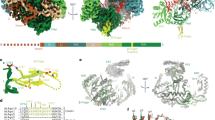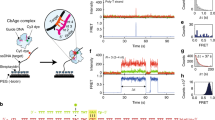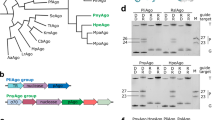Abstract
Argonaute proteins interact with small RNAs that guide them to complementary target RNAs, thus leading to inhibition of gene expression. Some but not all Argonaute proteins are endonucleases and can cleave the complementary target RNA. Here, we have mutated inactive human Ago1 and Ago3 and generated catalytic Argonaute proteins. We find that two short sequence elements at the N terminus are important for activity. In addition, PIWI-domain mutations in Ago1 may misarrange the catalytic center. Our work helps in understanding of the structural requirements that make an Argonaute protein an active endonucleolytic enzyme.
This is a preview of subscription content, access via your institution
Access options
Subscribe to this journal
Receive 12 print issues and online access
$189.00 per year
only $15.75 per issue
Buy this article
- Purchase on Springer Link
- Instant access to full article PDF
Prices may be subject to local taxes which are calculated during checkout




Similar content being viewed by others
References
Ender, C. & Meister, G. Argonaute proteins at a glance. J. Cell Sci. 123, 1819–1823 (2010).
Hutvagner, G. & Simard, M.J. Argonaute proteins: key players in RNA silencing. Nat. Rev. Mol. Cell Biol. 9, 22–32 (2008).
Jinek, M. & Doudna, J.A. A three-dimensional view of the molecular machinery of RNA interference. Nature 457, 405–412 (2009).
Tolia, N.H. & Joshua-Tor, L. Slicer and the argonautes. Nat. Chem. Biol. 3, 36–43 (2007).
Siomi, M.C., Sato, K., Pezic, D. & Aravin, A.A. PIWI-interacting small RNAs: the vanguard of genome defence. Nat. Rev. Mol. Cell Biol. 12, 246–258 (2011).
Nakanishi, K., Weinberg, D.E., Bartel, D.P. & Patel, D.J. Structure of yeast Argonaute with guide RNA. Nature 486, 368–374 (2012).
Liu, J. et al. Argonaute2 is the catalytic engine of mammalian RNAi. Science 305, 1437–1441 (2004).
Meister, G. et al. Human Argonaute2 mediates RNA cleavage targeted by miRNAs and siRNAs. Mol. Cell 15, 185–197 (2004).
Yekta, S., Shih, I.H. & Bartel, D.P. MicroRNA-directed cleavage of HOXB8 mRNA. Science 304, 594–596 (2004).
Cheloufi, S., Dos Santos, C.O., Chong, M.M. & Hannon, G.J. A dicer-independent miRNA biogenesis pathway that requires Ago catalysis. Nature 465, 584–589 (2010).
Cifuentes, D. et al. A novel miRNA processing pathway independent of Dicer requires Argonaute2 catalytic activity. Science 328, 1694–1698 (2010).
Yang, J.S. et al. Conserved vertebrate mir-451 provides a platform for Dicer-independent, Ago2-mediated microRNA biogenesis. Proc. Natl. Acad. Sci. USA 107, 15163–15168 (2010).
Kim, V.N., Han, J. & Siomi, M.C. Biogenesis of small RNAs in animals. Nat. Rev. Mol. Cell Biol. 10, 126–139 (2009).
Matranga, C., Tomari, Y., Shin, C., Bartel, D.P. & Zamore, P.D. Passenger-strand cleavage facilitates assembly of siRNA into Ago2-containing RNAi enzyme complexes. Cell 123, 607–620 (2005).
Rand, T.A., Petersen, S., Du, F. & Wang, X. Argonaute2 cleaves the anti-guide strand of siRNA during RISC activation. Cell 123, 621–629 (2005).
Leuschner, P.J., Ameres, S.L., Kueng, S. & Martinez, J. Cleavage of the siRNA passenger strand during RISC assembly in human cells. EMBO Rep. 7, 314–320 (2006).
Petri, S. et al. Increased siRNA duplex stability correlates with reduced off-target and elevated on-target effects. RNA 17, 737–749 (2011).
Gu, S. et al. Thermodynamic stability of small hairpin RNAs highly influences the loading process of different mammalian Argonautes. Proc. Natl. Acad. Sci. USA 108, 9208–9213 (2011).
Wang, B. et al. Distinct passenger strand and mRNA cleavage activities of human Argonaute proteins. Nat. Struct. Mol. Biol. 16, 1259–1266 (2009).
Schirle, N.T. & MacRae, I.J. The crystal structure of human Argonaute2. Science 336, 1037–1040 (2012).
Elkayam, E. et al. The structure of human argonaute-2 in complex with miR-20a. Cell 150, 100–110 (2012).
Hur, J.K., Zinchenko, M.K., Djuranovic, S. & Green, R. Regulation of Argonaute slicer activity by guide RNA 3′ end interactions with the N-terminal lobe. J. Biol. Chem. 288, 7829–7840 (2013).
Kwak, P.B. & Tomari, Y. The N domain of Argonaute drives duplex unwinding during RISC assembly. Nat. Struct. Mol. Biol. 19, 145–151 (2012).
Meister, G. et al. Human Argonaute2 mediates RNA cleavage targeted by miRNAs and siRNAs. Mol. Cell 15, 185–197 (2004).
Pall, G.S. & Hamilton, A.J. Improved northern blot method for enhanced detection of small RNA. Nat. Protoc. 3, 1077–1084 (2008).
Roy, A., Kucukural, A. & Zhang, Y. I-TASSER: a unified platform for automated protein structure and function prediction. Nat. Protoc. 5, 725–738 (2010).
Kabsch, W. & Sander, C. Dictionary of protein secondary structure: pattern recognition of hydrogen-bonded and geometrical features. Biopolymers 22, 2577–2637 (1983).
Acknowledgements
We thank S. Ammon and C. Friederich for technical assistance. Our research is supported by grants from the Deutsche Forschungsgemeinschaft (SFB 960 projects B3 and B4 to G.M. and FOR855 to G.M.), the European Research Council (grant 242792 'sRNAs' to G.M.), the Bavarian Genome Research Network (BayGene to G.M.), the Bavarian Systems-Biology Network (BioSysNet to G.M.) and the European Union (grant 201102 'ONCOMIRs' to G.M.).
Author information
Authors and Affiliations
Contributions
J.H., A.D. and G.M. designed the experiments. J.H. and A.D. performed the experiments. S.H. and J.P. prepared several Ago mutants and recombinant Ago proteins. R.M. did bioinformatical analyses and structural modeling. G.M. and J.H. wrote the manuscript.
Corresponding author
Ethics declarations
Competing interests
The authors declare no competing financial interests.
Supplementary information
Supplementary Text and Figures
Supplementary Figures 1 and 2 and Supplementary Table 1 (PDF 217 kb)
Rights and permissions
About this article
Cite this article
Hauptmann, J., Dueck, A., Harlander, S. et al. Turning catalytically inactive human Argonaute proteins into active slicer enzymes. Nat Struct Mol Biol 20, 814–817 (2013). https://doi.org/10.1038/nsmb.2577
Received:
Accepted:
Published:
Issue Date:
DOI: https://doi.org/10.1038/nsmb.2577
This article is cited by
-
AGO4 suppresses tumor growth by modulating autophagy and apoptosis via enhancing TRIM21-mediated ubiquitination of GRP78 in a p53-independent manner
Oncogene (2023)
-
Genome-wide identification, characterization and expression analysis of AGO, DCL, and RDR families in Chenopodium quinoa
Scientific Reports (2023)
-
Single-molecule FRET uncovers hidden conformations and dynamics of human Argonaute 2
Nature Communications (2022)
-
Argonaute proteins: structures and their endonuclease activity
Molecular Biology Reports (2021)
-
Distinct roles of Argonaute in the green alga Chlamydomonas reveal evolutionary conserved mode of miRNA-mediated gene expression
Scientific Reports (2019)



